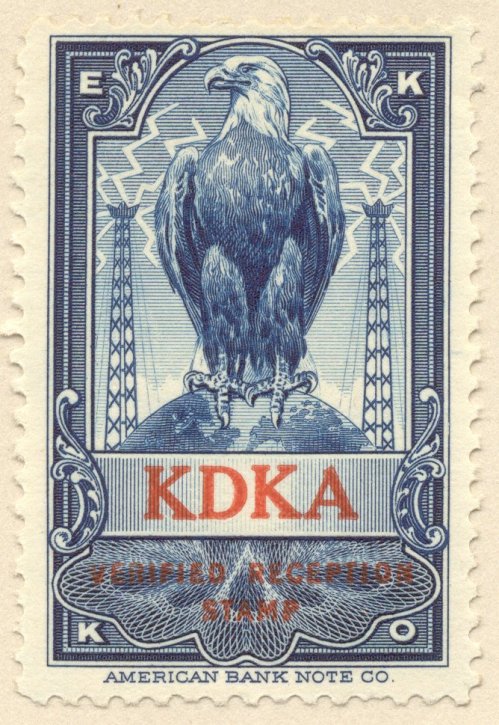
In the bottom of a box that came out of our mother’s attic (and which mostly contained old photos, about half of which were of people and places we did not recognize) Gretchen and I found a very odd thing indeed: a stamp album for “verified reception stamps.” The album was dated 1925, and had our grandfather Harry G. Duntemann’s ornate signature on the flyleaf. In the album were little rectangles just like you’d see in a postage stamp album, except that there was a rectangle for every commercial radio station that existed in the United States in 1925.
The album was part of a kit that included little folding cards that had a punchout for an American dime, and space for a handwritten signal report. The system worked like this: You heard a station on your Atwater Kent and wrote down the time, the frequency, signal strength, and a description of what was being broadcast. You fastened a dime into the punchout with provided gum-adhesive stickers that resemble unprinted stamps. You folded the card over, tucked it into an envelope, and mailed it to the radio station that you heard. Assuming that the station was participating in the program, they would send you their stamp to paste into your album.
How popular this system was is hard to tell, though there are some speculations on the Web. The process eventually became corrupt, as people bought the stamps from other collectors or direct from Ekko just to fill their albums. Counterfeits eventually appeared on the market and were used by unscrupulous stations; dimes were real money in those days. More on Ekko stamps here.
My grandfather evidently lost interest quickly, as he had a grand total of seven stamps scattered throughout the album, which has spaces for about 300. The one shown above is the one I like the most, as it came from Pittsburgh station KDKA, the very first commercially licensed broadcast station in the US, at 1020 on your AM dial since 1920. The stamps are beautifully engraved by the American Bank Note Company, but apart from the overprinted call letters and five or six color variations, the stamps are all exactly alike. The letters EKKO in the four corners of the stamp indicate the Ekko Company, which invented the system, provided the stamps to the radio stations, and sold the albums to the public. Radio was quite the red-hot hobby in the roaring 20s, but when the Great Depression closed in after 1929, paying a dime for a collectible stamp (when first-class postage stamps were still 2c) became a lot less compelling, and the Ekko Company swiftly and silently vanished away.
A system for confirming radio transmissions has long existed for shortwave listeners and (especially) ham radio ops, though it involves custom postcards instead of stamps. I did a lot of that when I was a kid, and probably got on somebody’s list of dangerous subversives by writing to Radio Havana Cuba for a QSL card in 1966. “QSL” is radio shorthand for “I confirm receipt of your transmission…” I’ve had several QSL cards, and you can see one of them here. There’s a whole book devoted (mostly) to ham radio QSL cards, and I recommend it if such things interest you.
And that’s it for this series. I have a few more odd things awaiting scanning in the file folder, but they’re thin gruel compared to what I’ve just shared here. Surely you’ve all seen a sheet of S&H Green Stamps! (Or maybe you haven’t. I may be older than I think.) And things like funeral holy cards and scapulars are an acquired taste. If I do find anything more generally notable I’ll post it in this space; stay tuned.











I used to listen to Radio Havana Cuba many years ago.
9.525 mhz. Used to find it by listening around for the set of tones they played before the show so you could find them…doo do dooo doo …..doodoodooo
They used to run essay contests where the topic would always be something like “How does capitalism harm the people” now entering one of those really would have got you on a list…all the US entries for those are probably still hidden away in some musty storage place. (Warehouse 13)